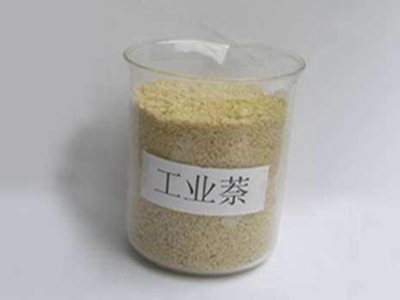The use of industrial naphthalene
With the improvement of the production process of phthalic anhydride, industrial naphthalene containing a small amount of unsaturated compounds has no adverse effects on the quality of phthalic anhydride products and the performance of catalysts. Therefore, many coking plants now use raw material fractions that have only undergone alkali washing to extract industrial naphthalene. So, what are the uses of industrial naphthalene? Let's take a look below.
Naphthalene and its derivatives are important raw materials in organic chemistry. Naphthalene and its derivatives can usually be extracted from coal tar and petroleum cracking tar, and are divided into industrial naphthalene, refined naphthalene, and methyl naphthalene. Coal tar naphthalene products have high sulfur content, while petroleum naphthalene products have low sulfur content and are more suitable for producing refined naphthalene, refined methyl naphthalene, etc. In the process of crude oil cracking to produce ethylene in the petrochemical industry, a large amount of ethylene cracking tar is co produced. In the past, there was no advanced separation proprietary technology, and the cracking tar was not only partially used to produce carbon black, but also used more as fuel oil, resulting in the loss and waste of valuable organic chemical raw materials.
Naphthalene and its derivatives are widely used in industries such as synthetic resins, coatings, pharmaceuticals, pesticides, light industry, plastics, and additives. They can be used to produce phthalic anhydride, β - naphthol, naphthylamine, H-acid, nitrile rubber, plasticizers, diffusers, anticoagulants, and other products. They should be fully utilized to maximize their economic benefits.

Specific operating methods for producing industrial naphthalene
The main operation process of producing industrial naphthalene with dual furnaces and twin towers is as follows: preparation before starting up, check whether the water, electricity, steam, and gas systems meet the adjustment and requirements for starting up. Check whether the equipment, pipelines, instruments, and safety devices belonging to the system are intact and complete. For parking and maintenance equipment, pipelines, and valves, they must pass pressure and leakage tests as required. Check whether the valve is open and closed, and whether the pipeline direction is correct.
Use steam to blow the pipeline (including jacket and companion pipe) to ensure smooth flow and no leakage. When sweeping the steam, pay attention to the pipelines of the sight glass and flow inspection device, and the steam must be bypassed; For pipelines that require steam sweeping through the pump, the pumping time should not be too long, and the steam valve should be immediately closed after sweeping;
Under normal circumstances, it is strictly prohibited to sweep steam into the tower. Prepare industrial naphthalene vaporization cooler circulating soft water, and feed it at a certain water temperature, usually around 25 ℃. Prepare the initial distillation tower dephenolic oil reflux solution. Ensure proper communication between the pre - and post production processes, balance the source and supply of raw materials, as well as the storage and transportation of products. Heating the raw oil for production to the specified temperature for sampling and analysis.
The above is an introduction to the uses of industrial naphthalene. If you need to learn more about industrial naphthalene and other small knowledge, please continue to follow us.
 Industrial naphthalene: a lone wolf in the deep processing i
Industrial naphthalene: a lone wolf in the deep processing i
 The use of industrial naphthalene
The use of industrial naphthalene
 Maleic anhydride is a bulk raw material. Do you know its ori
Maleic anhydride is a bulk raw material. Do you know its ori




